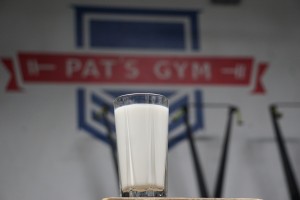 There are so many types of milk on the market you need to research the type that is right for you based upon your goals. Each milk has its pros and cons, so be knowledgeable and make knowing choices. In this knowledge post, I will briefly address the main attributes of each type of milk. For me, I stick with cow’s milk. I don’t worry about the saturated fat because my diet is pretty light on those types of fats, and I will burn most of it off in my workouts. However, for those of you who have other goals, please be informed and make knowledge-based choices.
There are so many types of milk on the market you need to research the type that is right for you based upon your goals. Each milk has its pros and cons, so be knowledgeable and make knowing choices. In this knowledge post, I will briefly address the main attributes of each type of milk. For me, I stick with cow’s milk. I don’t worry about the saturated fat because my diet is pretty light on those types of fats, and I will burn most of it off in my workouts. However, for those of you who have other goals, please be informed and make knowledge-based choices.
This post should serve as a primer on milk, but when buying a certain brand of milk read the ingredient list to make sure you’re getting what you want. Some will be fortified, other sweetened. Others will be organic, while others not.
Cow’s Milk – This type of milk is the most common. It is high in protein and contains calcium, vitamin D and phosphorous. This type of milk is also very high in protein. Because cow’s milk is high in protein and fat, depending upon if it is whole milk, you will feel full for a while after drinking this type of milk. The cons with cow’s milk will depend upon the type of milk selected. I always go for full fat because of the calcium content and because during “no fat” processing all of the fats will be removed, essentially leaving you with sugar. Some people worry about the saturated fat, but I don’t.
Goat’s Milk – This is popular for those who want milk coming out of an animal but want variety to cow’s milk or an alternative. Also, those who like goat cheese will generally like goat’s milk It’s very high in protein. However, it is high in saturated fat. I generally don’t like goat’s milk because of the taste; the saturated fat does not scare me away. Goat’s milk has a lot of important nutrients such as magnesium, potassium, and vitamins A and C. Many types of goat’s milk also come fortified with vitamin D, similar to cow’s milk.
Soy Milk – Soy milk is a popular alternative to cow’s milk. This type of milk is popular to those who are lactose-intolerant. Soy milk is low in fat, high in protein and is often fortified with vitamins A, B, and B12. Drinking soy milk has few drawbacks, though it’s important to look out for and avoid varieties that have been heavily sweetened. I don’t eat or drink a lot of soy because it suppresses testosterone levels, which I want to avoid since I don’t want to minimize the results of my working out.
Almond Milk – Almond milk is a very popular lactose-free alternative to cow’s milk. It has more Vitamin E than cow’s milk. It is also available in a variety of flavors and comes in varying fat contents. It’s also very low in calories, with one cup of unsweetened almond milk containing just 30 calories. The main drawback with almond milks is that it has relatively little protein when compared to cow’s milk. If you’re going to drink almond milks, I would recommend looking for the unsweetened variety.
Cashew Milk – Cashew milk is similar to almond milk. Generally, it comes with about 40 calories and 3.5 grams of fat per cup. Cashew milk is often fortified with vitamins D, B12 and A. Similar to almond milk, cashew milk is much lower in protein than soy or cow’s milk. Although, cashew milk may quench your thirst, it will not keep you full for long.
Coconut milk – Recently, coconut milk has become very popular. I’s a great source of healthy fat and generally has protein. In addition, it is low in calories and has a great taste. It’s become a go-to source of healthy fat and protein. Coconut milk is typically low in calories and has a unique taste but great taste. However, it does have a lot of fat – even more fat than other types of animal milk. Generally, it is sweetened, which means I won’t go for it. Also, the amount of protein it has in comparison to cow milk is very low. This is a second reason I won’t go for it.
Two other milks that are not as common, but are used some are:
Hemp Milk – Hemp milk is made from hemp. This type of milk is really high in omega-3 fatty acids, which is great for your heart. Also, omega-3 fatty acids have anti-inflammatory properties which help with recovery from working out. Hemp milk provides more iron than cow’s milk. However, hemp milk is low in protein. If this is your choice of milk, makes sure it is unsweetened and fortified with calcium and vitamins A and D.
Flax Milk – Flax milk is great because it is high in fiber and omega-3 fatty acids. Again, those omega-3 fatty acids are great for your heart and at reducing inflammation. It is typically low in fat and calories. Unlike coconut milk and hemp milk, flax milk is very high in protein. The drawbacks are few; however, flavored milk has a lot of sugar so make sure you avoid sweetened flax milk.
I hope that you found this post to be helpful. If you have further questions, contact Pat Gilles at pat@patsgym.com.
Milk
Get JACKedNIFE
IV Therapy
The Gift That Keeps On Giving
My Christmas gift this year from Roza.
December Monthly Challenge
November Monthly Challenge
Morning aerobic cardio work
Eat for energy, and avoid those energy zappers
A nice finisher to help with strength and growth…
Nutrition doesn’t need to confuse you but have a philosophy to guide you.
IV Therapy
The Gift That Keeps On Giving
My Christmas gift this year from Roza.
December Monthly Challenge
November Monthly Challenge
Morning aerobic cardio work
Eat for energy, and avoid those energy zappers
A nice finisher to help with strength and growth…
Nutrition doesn’t need to confuse you but have a philosophy to guide you.
